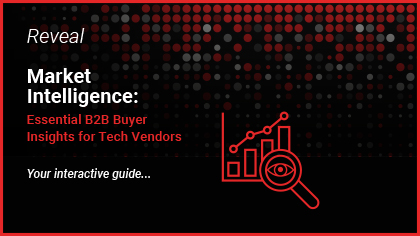Understanding the key performance indicators (KPIs) or metrics associated with B2B demand generation can be a pivotal factor in the success of your marketing efforts. Performance metrics help to accurately measure the effectiveness of your campaigns, enabling you to make data-driven decisions and optimize your B2B marketing strategies accordingly.
Tracking the right combination of metrics is vital in providing you with the relevant insights required to assess how well your campaign is delivering against your intended goals. B2B marketers require a broad range in order to select the most appropriate ones to measure, which is where the 12 KPIs explored in this article come into play…
Reading time: 4 minutes
What is B2B demand generation? Demand generation refers to any way of creating demand. It encompasses a vast range of marketing activities to create awareness and build interest in your product or service. It begins before you even identify a potential prospect right through to conversion, establishing your brand as an industry thought leader by addressing every touchpoint in the B2B buyer journey and nurturing long-term engagement.
Why should B2B marketers focus on demand gen KPIs?
Marketers in B2B businesses can benefit significantly from focusing on KPIs to measure their demand generation success, experiencing:
- Greater credibility
- Increased growth
- More informed marketing strategy
- Ability to understand what activities are working effectively and which are not.
Measuring key marketing metrics also allows for reliable and accurate reporting to senior managers and stakeholders, and to deliver this with confidence.
Let’s take a deep dive into the top 12 demand generation KPIs that every B2B marketer should have on their radar:
1. Marketing qualified leads (MQLs)
An MQL is a lead that has shown a higher-than-average interest in your products or services, and is more likely to become a customer than other leads. This interest is typically shown by actions such as downloading whitepapers, signing up for newsletters, attending webinars, or spending significant time on your website.
MQLs form the backbone of your lead generation efforts and serve as a measure of whether your marketing strategies are effectively attracting potential customers. By tracking the number of MQLs generated, you can gauge whether your demand generation efforts are moving in the right direction.
2. Sales qualified leads (SQLs) and sales accepted leads (SALs)
SQLs and SALs represent the next steps in the demand generation funnel. An SQL is a lead that the sales team deems ready for the next step in the sales process. These leads have shown a strong intent to purchase, such as downloading your media pack or requesting a demo.
SALs, on the other hand, are leads that have been vetted and accepted by the sales team for further nurturing. By tracking SQLs and SALs, you can understand how well your sales and marketing teams are working together to convert potential customers.
3. Cost per acquisition (CPA)
CPA is a crucial demand gen metric that indicates the average amount you spend to acquire a new customer. It includes the cost of all marketing initiatives, from digital ads and social media campaigns to email marketing. By comparing CPA with the revenue generated from each customer you can determine the profitability of your marketing strategies.
4. Activations and sign-ups
The number of activations and sign-ups is a direct reflection of the demand for your product or service. A high number suggests that your marketing efforts are successfully driving potential customers to engage with your brand. By tracking these metrics, you can monitor the growth of your user base and identify potential issues in your demand generation strategies.
5. Customer lifetime value (CLTV)
CLTV is the total revenue you expect to generate from a customer over the duration of their relationship with your company. It’s an essential metric that helps you understand how much value each customer brings to your business. By comparing CLTV with CPA, you can determine whether your marketing spend is justified and optimize your budget allocation accordingly.
6. Payback period
The payback period is the time it takes to recover the cost of acquiring a new customer. It’s a critical metric to track, as it gives you an understanding of when your marketing investments start generating returns. A shorter payback period indicates a more efficient demand generation strategy.
7. Content performance
Content is a crucial part of any demand generation strategy. By measuring the engagement levels of your content (shares, comments, likes, impressions), you can get a clear picture of how well your content resonates with your audience. This information can guide your content strategy, helping you create more engaging and effective content.
8. Close rate or marketing sourced pipeline
Close rate or marketing sourced pipeline is a key metric that indicates how many leads are converting into customers. It provides insights into the effectiveness of your marketing channels in driving conversions. By tracking the close rate for each marketing channel separately, you can identify which channels are most effective and focus your efforts accordingly.
9. Average deal size
The average deal size can offer valuable insights into the revenue potential of your leads. By segmenting your data based on the average deal size per channel or marketing campaign, you can identify which strategies are driving the most profitable deals and optimize your efforts accordingly.
10. Contribution to total revenue
Your demand gen efforts should ideally contribute significantly to your total revenue. By tracking this metric, you can assess the commercial impact of your marketing strategies and justify your marketing spend.
11. Brand sentiment
Brand sentiment is an essential measure of how your brand is perceived by your audience. Positive brand sentiment can help drive demand and foster customer loyalty. By monitoring brand sentiment, you can identify areas for improvement and take steps to enhance your brand’s image.
12. Days in status
Days in status refers to the amount of time a lead spends in each stage of the sales process. It’s an important metric that can help you identify bottlenecks in your sales funnel and optimize your lead nurturing process.
Over to you – measure your B2B demand gen success
By tracking these demand generation KPIs, you can gain valuable insights into your marketing performance and make informed decisions to optimize your strategies. Remember, the key to success in demand generation lies in aligning your metrics with your business goals and being patient as you work towards these goals.
Only then are you able to understand how well a campaign is delivering against its intentions.
Ready to take your demand generation efforts to the next level? Explore our Demand Generation services to learn how we can help you accelerate your demand and achieve your business goals.









